Advertisers are shifting away from YouTube’s six-second ‘bumper’ ad format, spending more on 15 second and 30 second formats, according to analysis from advertising intelligence platform MediaRadar. The study suggests that while there’s still a lot of debate around the value of ultra-short ads, advertisers have somewhat soured on six-second spots.
MediaRadar analysed the frequency of different video ad lengths across a variety digital video platforms, including YouTube, between Q1 2018 and Q1 2019. Across all of the streaming platforms, fifteen second ads were the most popular of all, accounting for around 40 percent of all video ads.
On YouTube, fifteen second spots were proportionally even more popular, making up 47 percent of all ads run on the platform. But MediaRadar found that the six second format’s popularity fell significantly during the time frame of its study, with six-second ads accounting for just 16.5 percent of YouTube ads at the start of 2019, a 20 percent decrease. Thirty second ads meanwhile become more popular, making up 24 percent of YouTube ads, a 19 percent increase year-on-year.
As MediaRadar CEO Todd Krizelman pointed out, YouTube opened up its non-skippable 15 second format, which was previously limited to just reserved buys and its Google Preferred network, to all buyers earlier this year. This could signal demand for advertisers for more mid-length and long formats on the platform. Krizelman speculated that advertisers might be switching formats “because longer video ads prove more effective, as they allow for more information to be conveyed”.
Others are reporting similarly seeing a shift towards longer formats. “We believe longer video ads in our games like Candy Crush see stronger lifts in brand measures vs. shorter creative lengths,” said Greg Carroll, commercial director for Activision Blizzard Media.
YouTube is still pushing its six second format, announcing this week that it’s testing new software which uses machine learning to condense longer videos down to six seconds. And Krizelman said that advertisers aren’t ruling out six second spots completely. “They certainly have a place in the attention economy; especially when a younger demographic is targeted,” he said.
But the data suggests that six seconds is too short for many to adequately get their message across. “This might be why we’re seeing the 15-second video ad as the house majority,” said Krizelman. “It just might be the video advertising sweet spot; balancing the desire to keep things short, but long enough to drive an emotional impact.”





